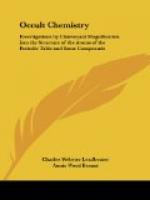I took the diagram for Osmium, and in a bar postulated only three columns for the first element of the new groups, i.e., one column less than in Osmium. This would make 183 atoms in a bar; the new group then would follow in a bar, 183, 185, 187. Here I found to my surprise that the third postulated group would have a remarkable relation to Os, Ir, Pt.
Thus
Os.—245
(in a bar); less 60 = 185
Ir.
247 less 60 = 187
Pt.
249 less 60 = 189
But strange to say also
Ruthenium (bar) 132
less 60—72
Rhodium 134
less 60—74
Palladium 136
less 60—76
But 72, 74, 76, are Iron, Cobalt and Nickel.
So there does probably exist a new group with bars (183), 185, 187, 189, with atomic weights.
X=bar 185; atoms
2590, wt. 143.3
Y= 187,
2618, wt. 145.4
Z= 189,
2646, wt. 147.0.
They come probably among the rare earths. Probably
also Neodymium and Praseodymium are two of them, for
their weights are 143.6, 140.5.
* * * * *
CHAPTER III.
THE LATER RESEARCHES.
The first difficulty that faced us was the identification of the forms seen on focusing the sight on gases.[2] We could only proceed tentatively. Thus, a very common form in the air had a sort of dumb-bell shape (see Plate I); we examined this, comparing our rough sketches, and counted its atoms; these, divided by 18—the number of ultimate atoms in hydrogen—gave us 23.22 as atomic weight, and this offered the presumption that it was sodium. We then took various substances—common salt, etc.—in which we knew sodium was present, and found the dumb-bell form in all. In other cases, we took small fragments of metals, as iron, tin, zinc, silver, gold; in others, again, pieces of ore, mineral waters, etc., etc., and, for the rarest substances, Mr. Leadbeater visited a mineralogical museum. In all, 57 chemical elements were examined, out of the 78 recognized by modern chemistry.
In addition to these, we found 3 chemical waifs: an unrecognized stranger between hydrogen and helium which we named occultum, for purposes of reference, and 2 varieties of one element, which we named kalon and meta-kalon, between xenon and osmium; we also found 4 varieties of 4 recognized elements and prefixed meta to the name of each, and a second form of platinum, that we named Pt. B. Thus we have tabulated in all 65 chemical elements, or chemical atoms, completing three of Sir William Crookes’ lemniscates, sufficient for some amount of generalization.
[Illustration: PLATE I. SODIUM.]




